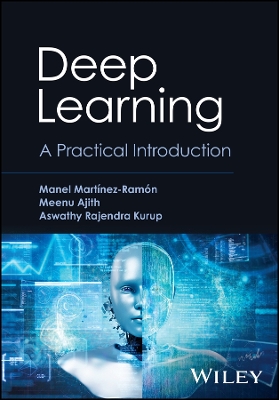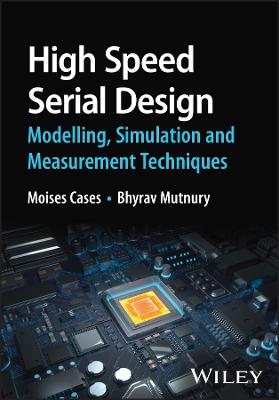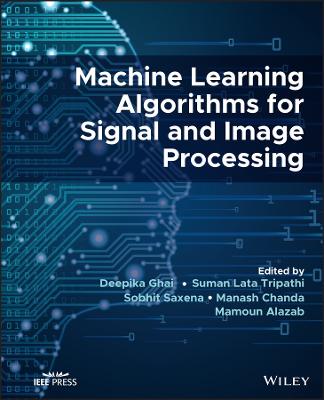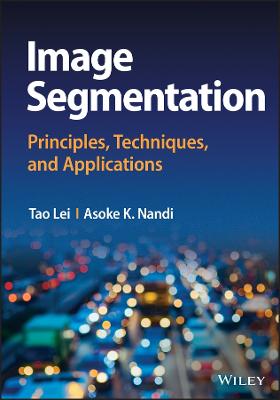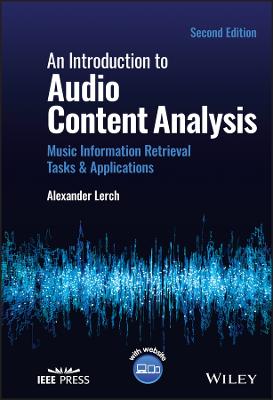Modeling and Optimization of Signals Using Machine Learning Techniques
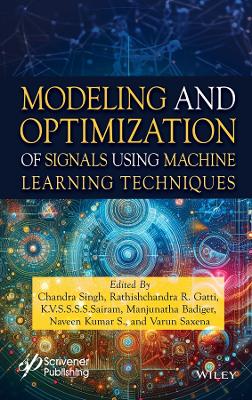 -15%
portes grátis
-15%
portes grátis
Modeling and Optimization of Signals Using Machine Learning Techniques
Badiger, Manjunatha; Gatti, Rathishchandra R.; Singh, Chandra; Sairam, K.V.S.S.S.S.; S., Naveen Kumar; Saxena, Varun
John Wiley & Sons Inc
09/2024
416
Dura
Inglês
9781119847687
15 a 20 dias
Descrição não disponível.
Preface xix
1 Land Use and Land Cover Mapping of Remotely Sensed Data Using Fuzzy Set Theory-Related Algorithm 1
Adithya Kumar and Shivakumar B.R.
1.1 Introduction 2
1.2 Image Classification 5
1.3 Unsupervised Classification 7
1.4 Supervised Classification 8
1.5 Overview of Fuzzy Sets 9
1.6 Methodology 11
1.7 Results and Discussion 16
1.8 Conclusion 21
2 Role of AI in Mortality Prediction in Intensive Care Unit Patients 23
Prabhudutta Ray, Sachin Sharma, Raj Rawal and Dharmesh Shah
2.1 Introduction 24
2.2 Background 24
2.3 Objectives 25
2.4 Machine Learning and Mortality Prediction 26
2.5 Discussions 34
2.6 Conclusion 34
2.7 Future Work 35
2.8 Acknowledgments 35
2.9 Funding 35
2.10 Competing Interest 35
3 A Survey on Malware Detection Using Machine Learning 41
Devika S. P., Pooja M. R. and Arpitha M. S.
3.1 Background 41
3.2 Introduction 42
3.3 Literature Survey 44
3.4 Discussion 53
3.5 Conclusion 53
4 EEG Data Analysis for IQ Test Using Machine Learning Approaches: A Survey 55
Bhoomika Patel H. C., Ravikumar V. and Pavan Kumar S. P.
4.1 Related Work 57
4.2 Equations 62
4.3 Classification 64
4.4 Data Set 65
4.5 Information Obtained by EEG Signals 69
4.6 Discussion 70
4.7 Conclusion 72
5 Machine Learning Methods in Radio Frequency and Microwave Domain 75
Shanthi P. and Adish K.
5.1 Introduction 76
5.2 Background on Machine Learning 77
5.3 ML in RF Circuit Modeling and Synthesis 86
5.4 Conclusion 93
6 A Survey: Emotion Detection Using Facial Reorganization Using Convolutional Neural Network (CNN) and Viola-Jones Algorithm 97
Vaibhav C. Gandhi, Dwij Kishor Siyal, Shivam Pankajkumar Patel and Arya Vipesh Shah
6.1 Introduction 98
6.2 Review of Literature 99
6.3 Report on Present Investigation 101
6.4 Algorithms 102
6.5 Viola-Jones Algorithm 104
6.6 Diagram 105
6.7 Results and Discussion 107
6.8 Limitations and Future Scope 111
6.9 Summary and Conclusion 111
7 Power Quality Events Classification Using Digital Signal Processing and Machine Learning Techniques 115
E. Fantin Irudaya Raj and M. Balaji
7.1 Introduction 116
7.2 Methodology for the Identification of PQ Events 117
7.3 Power Quality Problems Arising in the Modern Power System 118
7.4 Digital Signal Processing-Based Feature Extraction of PQ Events 124
7.5 Feature Selection and Optimization 129
7.6 Machine Learning-Based Classification of PQ Disturbances 131
7.7 Summary and Conclusion 141
8 Hybridization of Artificial Neural Network with Spotted Hyena Optimization (SHO) Algorithm for Heart Disease Detection 145
Shwetha N., Gangadhar N., Mahesh B. Neelagar, Sangeetha N. and Virupaxi Dalal
8.1 Introduction 146
8.2 Literature Survey 147
8.3 Proposed Methodology 149
8.4 Artificial Neural Network 152
8.5 Software Implementation Requirements 163
8.6 Conclusion 170
9 The Role of Artificial Intelligence, Machine Learning, and Deep Learning to Combat the Socio-Economic Impact of the Global COVID-19 Pandemic 173
Biswa Ranjan Senapati, Sipra Swain and Pabitra Mohan Khilar
9.1 Introduction 174
9.2 Discussions on the Coronavirus 175
9.3 Bad Impacts of the Coronavirus 180
9.4 Benefits Due to the Impact of COVID-19 186
9.5 Role of Technology to Combat the Global Pandemic COVID-19 190
9.6 The Role of Artificial Intelligence, Machine Learning, and Deep Learning in COVID-19 198
9.7 Related Studies 203
9.8 Conclusion 203
10 A Review on Smart Bin Management Systems 209
Bhoomika Patel H. C., Soundarya B. C. and Pooja M. R.
10.1 Introduction 209
10.1.1 Internet of Things (IoT) 210
10.2 Related Work 211
10.3 Challenges, Solution, and Issues 213
10.4 Advantages 216
11 Unlocking Machine Learning: 10 Innovative Avenues to Grasp Complex Concepts 219
K. Vidhyalakshmi and S. Thanga Ramya
11.1 Regression 220
11.2 Classification 222
11.3 Clustering 227
11.4 Clustering (k-means) 227
11.5 Reduction of Dimensionality 230
11.6 The Ensemble Method 233
11.7 Transfer of Learning 240
11.8 Learning Through Reinforcement 241
11.9 Processing of Natural Languages 242
11.10 Word Embeddings 242
11.11 Conclusion 243
12 Recognition Attendance System Ensuring COVID-19 Security 245
Praveen Kumar M., Ramya Poojary, Saksha S. Bhandary and Sushmitha M. Kulal
12.1 Introduction 246
12.2 Literature Survey 246
12.3 Software Requirements 248
12.4 Hardware Requirements 249
12.5 Methodology 252
12.6 Building the Database 253
12.7 Pi Camera for Extracting Face Features 255
12.8 Real-Time Testing on Raspberry Pi 256
12.9 Contactless Body Temperature Monitoring 256
12.10 Raspberry-Pi Setting Up an SMTP Email 258
12.11 Uploading to the Database 259
12.12 Updating the Website 260
12.13 Report Generation 260
12.14 Result 262
12.15 Discussion 267
12.16 Conclusion 267
13 Real-Time Industrial Noise Cancellation for the Extraction of Human Voice 271
Vinayprasad M. S., Chandrashekar Murthy B. N. and Yashwanth S. D.
13.1 Introduction 272
13.2 Literature Survey 273
13.3 Methodology 275
13.4 Experimental Results 278
13.5 Conclusion 280
14 Machine Learning-Based Water Monitoring System Using IoT 283
T. Kesavan, E. Kaliappan, K. Nagendran and M. Murugesan
14.1 Introduction 283
14.2 Smart Water Monitoring System 284
14.3 Sensors and Hardware 286
14.4 PowerBI Reports 288
14.5 Conclusion 291
15 Design and Modelling of an Automated Driving Inspector Powered by Arduino and Raspberry Pi 295
Raghunandan K. R., Dilip Kumar K., Krishnaraj Rao N.S. Krishnaprasad Rao and Bhavya K.
15.1 Introduction 296
15.2 Literature Survey 296
15.3 Results 306
15.4 Conclusion 309
16 Kalman Filter-Based Seizure Prediction Using Concatenated Serial-Parallel Block Technique 313
Purnima P. S. and Suresh M.
16.1 Introduction 314
16.2 Prior Work 314
16.3 Proposed Method 316
16.4 Serial-Parallel Block Concatenation Approach 318
16.5 Algorithm 319
16.6 Kalman Filter 320
16.7 Results and Discussion 321
16.8 Conclusion 323
17 Current Advancements in Steganography: A Review 327
Mallika Garg, Jagpal Singh Ubhi and Ashwani Kumar Aggarwal
17.1 Introduction 328
17.2 Evaluation Parameters 329
17.3 Types of Steganography 330
17.4 Traditional Steganographic Techniques 332
17.5 CNN-Based Steganographic Techniques 336
17.6 GAN-Based Steganographic Techniques 338
17.7 Steganalysis 340
17.8 Applications 341
17.9 Dataset Used for Steganography 341
17.10 Conclusion 344
18 Human Emotion Recognition Intelligence System Using Machine Learning 349
Bhakthi P. Alva, Krishma Bopanna N., Prajwal S., Varun A. Naik and Lahari Vaidya
18.1 Introduction 350
18.2 Literature Review 350
18.3 Problem Statement 352
18.4 Methodology 353
18.5 Results 355
18.6 Applications 355
18.7 Conclusion 357
18.8 Future Work 357
19 Computing in Cognitive Science Using Ensemble Learning 361
Om Prakash Singh
19.1 Introduction 362
19.2 Recognition of Human Activities 363
19.3 Methodology 366
19.4 Applying the Boosting-Based Ensemble Learning 369
19.5 Human Activity Features Computability 373
19.6 Conclusion 378
References 378
About the Editors 383
Index 385
1 Land Use and Land Cover Mapping of Remotely Sensed Data Using Fuzzy Set Theory-Related Algorithm 1
Adithya Kumar and Shivakumar B.R.
1.1 Introduction 2
1.2 Image Classification 5
1.3 Unsupervised Classification 7
1.4 Supervised Classification 8
1.5 Overview of Fuzzy Sets 9
1.6 Methodology 11
1.7 Results and Discussion 16
1.8 Conclusion 21
2 Role of AI in Mortality Prediction in Intensive Care Unit Patients 23
Prabhudutta Ray, Sachin Sharma, Raj Rawal and Dharmesh Shah
2.1 Introduction 24
2.2 Background 24
2.3 Objectives 25
2.4 Machine Learning and Mortality Prediction 26
2.5 Discussions 34
2.6 Conclusion 34
2.7 Future Work 35
2.8 Acknowledgments 35
2.9 Funding 35
2.10 Competing Interest 35
3 A Survey on Malware Detection Using Machine Learning 41
Devika S. P., Pooja M. R. and Arpitha M. S.
3.1 Background 41
3.2 Introduction 42
3.3 Literature Survey 44
3.4 Discussion 53
3.5 Conclusion 53
4 EEG Data Analysis for IQ Test Using Machine Learning Approaches: A Survey 55
Bhoomika Patel H. C., Ravikumar V. and Pavan Kumar S. P.
4.1 Related Work 57
4.2 Equations 62
4.3 Classification 64
4.4 Data Set 65
4.5 Information Obtained by EEG Signals 69
4.6 Discussion 70
4.7 Conclusion 72
5 Machine Learning Methods in Radio Frequency and Microwave Domain 75
Shanthi P. and Adish K.
5.1 Introduction 76
5.2 Background on Machine Learning 77
5.3 ML in RF Circuit Modeling and Synthesis 86
5.4 Conclusion 93
6 A Survey: Emotion Detection Using Facial Reorganization Using Convolutional Neural Network (CNN) and Viola-Jones Algorithm 97
Vaibhav C. Gandhi, Dwij Kishor Siyal, Shivam Pankajkumar Patel and Arya Vipesh Shah
6.1 Introduction 98
6.2 Review of Literature 99
6.3 Report on Present Investigation 101
6.4 Algorithms 102
6.5 Viola-Jones Algorithm 104
6.6 Diagram 105
6.7 Results and Discussion 107
6.8 Limitations and Future Scope 111
6.9 Summary and Conclusion 111
7 Power Quality Events Classification Using Digital Signal Processing and Machine Learning Techniques 115
E. Fantin Irudaya Raj and M. Balaji
7.1 Introduction 116
7.2 Methodology for the Identification of PQ Events 117
7.3 Power Quality Problems Arising in the Modern Power System 118
7.4 Digital Signal Processing-Based Feature Extraction of PQ Events 124
7.5 Feature Selection and Optimization 129
7.6 Machine Learning-Based Classification of PQ Disturbances 131
7.7 Summary and Conclusion 141
8 Hybridization of Artificial Neural Network with Spotted Hyena Optimization (SHO) Algorithm for Heart Disease Detection 145
Shwetha N., Gangadhar N., Mahesh B. Neelagar, Sangeetha N. and Virupaxi Dalal
8.1 Introduction 146
8.2 Literature Survey 147
8.3 Proposed Methodology 149
8.4 Artificial Neural Network 152
8.5 Software Implementation Requirements 163
8.6 Conclusion 170
9 The Role of Artificial Intelligence, Machine Learning, and Deep Learning to Combat the Socio-Economic Impact of the Global COVID-19 Pandemic 173
Biswa Ranjan Senapati, Sipra Swain and Pabitra Mohan Khilar
9.1 Introduction 174
9.2 Discussions on the Coronavirus 175
9.3 Bad Impacts of the Coronavirus 180
9.4 Benefits Due to the Impact of COVID-19 186
9.5 Role of Technology to Combat the Global Pandemic COVID-19 190
9.6 The Role of Artificial Intelligence, Machine Learning, and Deep Learning in COVID-19 198
9.7 Related Studies 203
9.8 Conclusion 203
10 A Review on Smart Bin Management Systems 209
Bhoomika Patel H. C., Soundarya B. C. and Pooja M. R.
10.1 Introduction 209
10.1.1 Internet of Things (IoT) 210
10.2 Related Work 211
10.3 Challenges, Solution, and Issues 213
10.4 Advantages 216
11 Unlocking Machine Learning: 10 Innovative Avenues to Grasp Complex Concepts 219
K. Vidhyalakshmi and S. Thanga Ramya
11.1 Regression 220
11.2 Classification 222
11.3 Clustering 227
11.4 Clustering (k-means) 227
11.5 Reduction of Dimensionality 230
11.6 The Ensemble Method 233
11.7 Transfer of Learning 240
11.8 Learning Through Reinforcement 241
11.9 Processing of Natural Languages 242
11.10 Word Embeddings 242
11.11 Conclusion 243
12 Recognition Attendance System Ensuring COVID-19 Security 245
Praveen Kumar M., Ramya Poojary, Saksha S. Bhandary and Sushmitha M. Kulal
12.1 Introduction 246
12.2 Literature Survey 246
12.3 Software Requirements 248
12.4 Hardware Requirements 249
12.5 Methodology 252
12.6 Building the Database 253
12.7 Pi Camera for Extracting Face Features 255
12.8 Real-Time Testing on Raspberry Pi 256
12.9 Contactless Body Temperature Monitoring 256
12.10 Raspberry-Pi Setting Up an SMTP Email 258
12.11 Uploading to the Database 259
12.12 Updating the Website 260
12.13 Report Generation 260
12.14 Result 262
12.15 Discussion 267
12.16 Conclusion 267
13 Real-Time Industrial Noise Cancellation for the Extraction of Human Voice 271
Vinayprasad M. S., Chandrashekar Murthy B. N. and Yashwanth S. D.
13.1 Introduction 272
13.2 Literature Survey 273
13.3 Methodology 275
13.4 Experimental Results 278
13.5 Conclusion 280
14 Machine Learning-Based Water Monitoring System Using IoT 283
T. Kesavan, E. Kaliappan, K. Nagendran and M. Murugesan
14.1 Introduction 283
14.2 Smart Water Monitoring System 284
14.3 Sensors and Hardware 286
14.4 PowerBI Reports 288
14.5 Conclusion 291
15 Design and Modelling of an Automated Driving Inspector Powered by Arduino and Raspberry Pi 295
Raghunandan K. R., Dilip Kumar K., Krishnaraj Rao N.S. Krishnaprasad Rao and Bhavya K.
15.1 Introduction 296
15.2 Literature Survey 296
15.3 Results 306
15.4 Conclusion 309
16 Kalman Filter-Based Seizure Prediction Using Concatenated Serial-Parallel Block Technique 313
Purnima P. S. and Suresh M.
16.1 Introduction 314
16.2 Prior Work 314
16.3 Proposed Method 316
16.4 Serial-Parallel Block Concatenation Approach 318
16.5 Algorithm 319
16.6 Kalman Filter 320
16.7 Results and Discussion 321
16.8 Conclusion 323
17 Current Advancements in Steganography: A Review 327
Mallika Garg, Jagpal Singh Ubhi and Ashwani Kumar Aggarwal
17.1 Introduction 328
17.2 Evaluation Parameters 329
17.3 Types of Steganography 330
17.4 Traditional Steganographic Techniques 332
17.5 CNN-Based Steganographic Techniques 336
17.6 GAN-Based Steganographic Techniques 338
17.7 Steganalysis 340
17.8 Applications 341
17.9 Dataset Used for Steganography 341
17.10 Conclusion 344
18 Human Emotion Recognition Intelligence System Using Machine Learning 349
Bhakthi P. Alva, Krishma Bopanna N., Prajwal S., Varun A. Naik and Lahari Vaidya
18.1 Introduction 350
18.2 Literature Review 350
18.3 Problem Statement 352
18.4 Methodology 353
18.5 Results 355
18.6 Applications 355
18.7 Conclusion 357
18.8 Future Work 357
19 Computing in Cognitive Science Using Ensemble Learning 361
Om Prakash Singh
19.1 Introduction 362
19.2 Recognition of Human Activities 363
19.3 Methodology 366
19.4 Applying the Boosting-Based Ensemble Learning 369
19.5 Human Activity Features Computability 373
19.6 Conclusion 378
References 378
About the Editors 383
Index 385
Este título pertence ao(s) assunto(s) indicados(s). Para ver outros títulos clique no assunto desejado.
Signal Processing; Machine Learning; Optimization; Signal Modeling; Neural Networks; Supervised Learning; Unsupervised Learning; Reinforcement Learning; Signal Classification; Regression; Clustering; Principal Component Analysis; Dimensionality Reduction; Adaptive Signal Processing; Telecommunications
Preface xix
1 Land Use and Land Cover Mapping of Remotely Sensed Data Using Fuzzy Set Theory-Related Algorithm 1
Adithya Kumar and Shivakumar B.R.
1.1 Introduction 2
1.2 Image Classification 5
1.3 Unsupervised Classification 7
1.4 Supervised Classification 8
1.5 Overview of Fuzzy Sets 9
1.6 Methodology 11
1.7 Results and Discussion 16
1.8 Conclusion 21
2 Role of AI in Mortality Prediction in Intensive Care Unit Patients 23
Prabhudutta Ray, Sachin Sharma, Raj Rawal and Dharmesh Shah
2.1 Introduction 24
2.2 Background 24
2.3 Objectives 25
2.4 Machine Learning and Mortality Prediction 26
2.5 Discussions 34
2.6 Conclusion 34
2.7 Future Work 35
2.8 Acknowledgments 35
2.9 Funding 35
2.10 Competing Interest 35
3 A Survey on Malware Detection Using Machine Learning 41
Devika S. P., Pooja M. R. and Arpitha M. S.
3.1 Background 41
3.2 Introduction 42
3.3 Literature Survey 44
3.4 Discussion 53
3.5 Conclusion 53
4 EEG Data Analysis for IQ Test Using Machine Learning Approaches: A Survey 55
Bhoomika Patel H. C., Ravikumar V. and Pavan Kumar S. P.
4.1 Related Work 57
4.2 Equations 62
4.3 Classification 64
4.4 Data Set 65
4.5 Information Obtained by EEG Signals 69
4.6 Discussion 70
4.7 Conclusion 72
5 Machine Learning Methods in Radio Frequency and Microwave Domain 75
Shanthi P. and Adish K.
5.1 Introduction 76
5.2 Background on Machine Learning 77
5.3 ML in RF Circuit Modeling and Synthesis 86
5.4 Conclusion 93
6 A Survey: Emotion Detection Using Facial Reorganization Using Convolutional Neural Network (CNN) and Viola-Jones Algorithm 97
Vaibhav C. Gandhi, Dwij Kishor Siyal, Shivam Pankajkumar Patel and Arya Vipesh Shah
6.1 Introduction 98
6.2 Review of Literature 99
6.3 Report on Present Investigation 101
6.4 Algorithms 102
6.5 Viola-Jones Algorithm 104
6.6 Diagram 105
6.7 Results and Discussion 107
6.8 Limitations and Future Scope 111
6.9 Summary and Conclusion 111
7 Power Quality Events Classification Using Digital Signal Processing and Machine Learning Techniques 115
E. Fantin Irudaya Raj and M. Balaji
7.1 Introduction 116
7.2 Methodology for the Identification of PQ Events 117
7.3 Power Quality Problems Arising in the Modern Power System 118
7.4 Digital Signal Processing-Based Feature Extraction of PQ Events 124
7.5 Feature Selection and Optimization 129
7.6 Machine Learning-Based Classification of PQ Disturbances 131
7.7 Summary and Conclusion 141
8 Hybridization of Artificial Neural Network with Spotted Hyena Optimization (SHO) Algorithm for Heart Disease Detection 145
Shwetha N., Gangadhar N., Mahesh B. Neelagar, Sangeetha N. and Virupaxi Dalal
8.1 Introduction 146
8.2 Literature Survey 147
8.3 Proposed Methodology 149
8.4 Artificial Neural Network 152
8.5 Software Implementation Requirements 163
8.6 Conclusion 170
9 The Role of Artificial Intelligence, Machine Learning, and Deep Learning to Combat the Socio-Economic Impact of the Global COVID-19 Pandemic 173
Biswa Ranjan Senapati, Sipra Swain and Pabitra Mohan Khilar
9.1 Introduction 174
9.2 Discussions on the Coronavirus 175
9.3 Bad Impacts of the Coronavirus 180
9.4 Benefits Due to the Impact of COVID-19 186
9.5 Role of Technology to Combat the Global Pandemic COVID-19 190
9.6 The Role of Artificial Intelligence, Machine Learning, and Deep Learning in COVID-19 198
9.7 Related Studies 203
9.8 Conclusion 203
10 A Review on Smart Bin Management Systems 209
Bhoomika Patel H. C., Soundarya B. C. and Pooja M. R.
10.1 Introduction 209
10.1.1 Internet of Things (IoT) 210
10.2 Related Work 211
10.3 Challenges, Solution, and Issues 213
10.4 Advantages 216
11 Unlocking Machine Learning: 10 Innovative Avenues to Grasp Complex Concepts 219
K. Vidhyalakshmi and S. Thanga Ramya
11.1 Regression 220
11.2 Classification 222
11.3 Clustering 227
11.4 Clustering (k-means) 227
11.5 Reduction of Dimensionality 230
11.6 The Ensemble Method 233
11.7 Transfer of Learning 240
11.8 Learning Through Reinforcement 241
11.9 Processing of Natural Languages 242
11.10 Word Embeddings 242
11.11 Conclusion 243
12 Recognition Attendance System Ensuring COVID-19 Security 245
Praveen Kumar M., Ramya Poojary, Saksha S. Bhandary and Sushmitha M. Kulal
12.1 Introduction 246
12.2 Literature Survey 246
12.3 Software Requirements 248
12.4 Hardware Requirements 249
12.5 Methodology 252
12.6 Building the Database 253
12.7 Pi Camera for Extracting Face Features 255
12.8 Real-Time Testing on Raspberry Pi 256
12.9 Contactless Body Temperature Monitoring 256
12.10 Raspberry-Pi Setting Up an SMTP Email 258
12.11 Uploading to the Database 259
12.12 Updating the Website 260
12.13 Report Generation 260
12.14 Result 262
12.15 Discussion 267
12.16 Conclusion 267
13 Real-Time Industrial Noise Cancellation for the Extraction of Human Voice 271
Vinayprasad M. S., Chandrashekar Murthy B. N. and Yashwanth S. D.
13.1 Introduction 272
13.2 Literature Survey 273
13.3 Methodology 275
13.4 Experimental Results 278
13.5 Conclusion 280
14 Machine Learning-Based Water Monitoring System Using IoT 283
T. Kesavan, E. Kaliappan, K. Nagendran and M. Murugesan
14.1 Introduction 283
14.2 Smart Water Monitoring System 284
14.3 Sensors and Hardware 286
14.4 PowerBI Reports 288
14.5 Conclusion 291
15 Design and Modelling of an Automated Driving Inspector Powered by Arduino and Raspberry Pi 295
Raghunandan K. R., Dilip Kumar K., Krishnaraj Rao N.S. Krishnaprasad Rao and Bhavya K.
15.1 Introduction 296
15.2 Literature Survey 296
15.3 Results 306
15.4 Conclusion 309
16 Kalman Filter-Based Seizure Prediction Using Concatenated Serial-Parallel Block Technique 313
Purnima P. S. and Suresh M.
16.1 Introduction 314
16.2 Prior Work 314
16.3 Proposed Method 316
16.4 Serial-Parallel Block Concatenation Approach 318
16.5 Algorithm 319
16.6 Kalman Filter 320
16.7 Results and Discussion 321
16.8 Conclusion 323
17 Current Advancements in Steganography: A Review 327
Mallika Garg, Jagpal Singh Ubhi and Ashwani Kumar Aggarwal
17.1 Introduction 328
17.2 Evaluation Parameters 329
17.3 Types of Steganography 330
17.4 Traditional Steganographic Techniques 332
17.5 CNN-Based Steganographic Techniques 336
17.6 GAN-Based Steganographic Techniques 338
17.7 Steganalysis 340
17.8 Applications 341
17.9 Dataset Used for Steganography 341
17.10 Conclusion 344
18 Human Emotion Recognition Intelligence System Using Machine Learning 349
Bhakthi P. Alva, Krishma Bopanna N., Prajwal S., Varun A. Naik and Lahari Vaidya
18.1 Introduction 350
18.2 Literature Review 350
18.3 Problem Statement 352
18.4 Methodology 353
18.5 Results 355
18.6 Applications 355
18.7 Conclusion 357
18.8 Future Work 357
19 Computing in Cognitive Science Using Ensemble Learning 361
Om Prakash Singh
19.1 Introduction 362
19.2 Recognition of Human Activities 363
19.3 Methodology 366
19.4 Applying the Boosting-Based Ensemble Learning 369
19.5 Human Activity Features Computability 373
19.6 Conclusion 378
References 378
About the Editors 383
Index 385
1 Land Use and Land Cover Mapping of Remotely Sensed Data Using Fuzzy Set Theory-Related Algorithm 1
Adithya Kumar and Shivakumar B.R.
1.1 Introduction 2
1.2 Image Classification 5
1.3 Unsupervised Classification 7
1.4 Supervised Classification 8
1.5 Overview of Fuzzy Sets 9
1.6 Methodology 11
1.7 Results and Discussion 16
1.8 Conclusion 21
2 Role of AI in Mortality Prediction in Intensive Care Unit Patients 23
Prabhudutta Ray, Sachin Sharma, Raj Rawal and Dharmesh Shah
2.1 Introduction 24
2.2 Background 24
2.3 Objectives 25
2.4 Machine Learning and Mortality Prediction 26
2.5 Discussions 34
2.6 Conclusion 34
2.7 Future Work 35
2.8 Acknowledgments 35
2.9 Funding 35
2.10 Competing Interest 35
3 A Survey on Malware Detection Using Machine Learning 41
Devika S. P., Pooja M. R. and Arpitha M. S.
3.1 Background 41
3.2 Introduction 42
3.3 Literature Survey 44
3.4 Discussion 53
3.5 Conclusion 53
4 EEG Data Analysis for IQ Test Using Machine Learning Approaches: A Survey 55
Bhoomika Patel H. C., Ravikumar V. and Pavan Kumar S. P.
4.1 Related Work 57
4.2 Equations 62
4.3 Classification 64
4.4 Data Set 65
4.5 Information Obtained by EEG Signals 69
4.6 Discussion 70
4.7 Conclusion 72
5 Machine Learning Methods in Radio Frequency and Microwave Domain 75
Shanthi P. and Adish K.
5.1 Introduction 76
5.2 Background on Machine Learning 77
5.3 ML in RF Circuit Modeling and Synthesis 86
5.4 Conclusion 93
6 A Survey: Emotion Detection Using Facial Reorganization Using Convolutional Neural Network (CNN) and Viola-Jones Algorithm 97
Vaibhav C. Gandhi, Dwij Kishor Siyal, Shivam Pankajkumar Patel and Arya Vipesh Shah
6.1 Introduction 98
6.2 Review of Literature 99
6.3 Report on Present Investigation 101
6.4 Algorithms 102
6.5 Viola-Jones Algorithm 104
6.6 Diagram 105
6.7 Results and Discussion 107
6.8 Limitations and Future Scope 111
6.9 Summary and Conclusion 111
7 Power Quality Events Classification Using Digital Signal Processing and Machine Learning Techniques 115
E. Fantin Irudaya Raj and M. Balaji
7.1 Introduction 116
7.2 Methodology for the Identification of PQ Events 117
7.3 Power Quality Problems Arising in the Modern Power System 118
7.4 Digital Signal Processing-Based Feature Extraction of PQ Events 124
7.5 Feature Selection and Optimization 129
7.6 Machine Learning-Based Classification of PQ Disturbances 131
7.7 Summary and Conclusion 141
8 Hybridization of Artificial Neural Network with Spotted Hyena Optimization (SHO) Algorithm for Heart Disease Detection 145
Shwetha N., Gangadhar N., Mahesh B. Neelagar, Sangeetha N. and Virupaxi Dalal
8.1 Introduction 146
8.2 Literature Survey 147
8.3 Proposed Methodology 149
8.4 Artificial Neural Network 152
8.5 Software Implementation Requirements 163
8.6 Conclusion 170
9 The Role of Artificial Intelligence, Machine Learning, and Deep Learning to Combat the Socio-Economic Impact of the Global COVID-19 Pandemic 173
Biswa Ranjan Senapati, Sipra Swain and Pabitra Mohan Khilar
9.1 Introduction 174
9.2 Discussions on the Coronavirus 175
9.3 Bad Impacts of the Coronavirus 180
9.4 Benefits Due to the Impact of COVID-19 186
9.5 Role of Technology to Combat the Global Pandemic COVID-19 190
9.6 The Role of Artificial Intelligence, Machine Learning, and Deep Learning in COVID-19 198
9.7 Related Studies 203
9.8 Conclusion 203
10 A Review on Smart Bin Management Systems 209
Bhoomika Patel H. C., Soundarya B. C. and Pooja M. R.
10.1 Introduction 209
10.1.1 Internet of Things (IoT) 210
10.2 Related Work 211
10.3 Challenges, Solution, and Issues 213
10.4 Advantages 216
11 Unlocking Machine Learning: 10 Innovative Avenues to Grasp Complex Concepts 219
K. Vidhyalakshmi and S. Thanga Ramya
11.1 Regression 220
11.2 Classification 222
11.3 Clustering 227
11.4 Clustering (k-means) 227
11.5 Reduction of Dimensionality 230
11.6 The Ensemble Method 233
11.7 Transfer of Learning 240
11.8 Learning Through Reinforcement 241
11.9 Processing of Natural Languages 242
11.10 Word Embeddings 242
11.11 Conclusion 243
12 Recognition Attendance System Ensuring COVID-19 Security 245
Praveen Kumar M., Ramya Poojary, Saksha S. Bhandary and Sushmitha M. Kulal
12.1 Introduction 246
12.2 Literature Survey 246
12.3 Software Requirements 248
12.4 Hardware Requirements 249
12.5 Methodology 252
12.6 Building the Database 253
12.7 Pi Camera for Extracting Face Features 255
12.8 Real-Time Testing on Raspberry Pi 256
12.9 Contactless Body Temperature Monitoring 256
12.10 Raspberry-Pi Setting Up an SMTP Email 258
12.11 Uploading to the Database 259
12.12 Updating the Website 260
12.13 Report Generation 260
12.14 Result 262
12.15 Discussion 267
12.16 Conclusion 267
13 Real-Time Industrial Noise Cancellation for the Extraction of Human Voice 271
Vinayprasad M. S., Chandrashekar Murthy B. N. and Yashwanth S. D.
13.1 Introduction 272
13.2 Literature Survey 273
13.3 Methodology 275
13.4 Experimental Results 278
13.5 Conclusion 280
14 Machine Learning-Based Water Monitoring System Using IoT 283
T. Kesavan, E. Kaliappan, K. Nagendran and M. Murugesan
14.1 Introduction 283
14.2 Smart Water Monitoring System 284
14.3 Sensors and Hardware 286
14.4 PowerBI Reports 288
14.5 Conclusion 291
15 Design and Modelling of an Automated Driving Inspector Powered by Arduino and Raspberry Pi 295
Raghunandan K. R., Dilip Kumar K., Krishnaraj Rao N.S. Krishnaprasad Rao and Bhavya K.
15.1 Introduction 296
15.2 Literature Survey 296
15.3 Results 306
15.4 Conclusion 309
16 Kalman Filter-Based Seizure Prediction Using Concatenated Serial-Parallel Block Technique 313
Purnima P. S. and Suresh M.
16.1 Introduction 314
16.2 Prior Work 314
16.3 Proposed Method 316
16.4 Serial-Parallel Block Concatenation Approach 318
16.5 Algorithm 319
16.6 Kalman Filter 320
16.7 Results and Discussion 321
16.8 Conclusion 323
17 Current Advancements in Steganography: A Review 327
Mallika Garg, Jagpal Singh Ubhi and Ashwani Kumar Aggarwal
17.1 Introduction 328
17.2 Evaluation Parameters 329
17.3 Types of Steganography 330
17.4 Traditional Steganographic Techniques 332
17.5 CNN-Based Steganographic Techniques 336
17.6 GAN-Based Steganographic Techniques 338
17.7 Steganalysis 340
17.8 Applications 341
17.9 Dataset Used for Steganography 341
17.10 Conclusion 344
18 Human Emotion Recognition Intelligence System Using Machine Learning 349
Bhakthi P. Alva, Krishma Bopanna N., Prajwal S., Varun A. Naik and Lahari Vaidya
18.1 Introduction 350
18.2 Literature Review 350
18.3 Problem Statement 352
18.4 Methodology 353
18.5 Results 355
18.6 Applications 355
18.7 Conclusion 357
18.8 Future Work 357
19 Computing in Cognitive Science Using Ensemble Learning 361
Om Prakash Singh
19.1 Introduction 362
19.2 Recognition of Human Activities 363
19.3 Methodology 366
19.4 Applying the Boosting-Based Ensemble Learning 369
19.5 Human Activity Features Computability 373
19.6 Conclusion 378
References 378
About the Editors 383
Index 385
Este título pertence ao(s) assunto(s) indicados(s). Para ver outros títulos clique no assunto desejado.
Signal Processing; Machine Learning; Optimization; Signal Modeling; Neural Networks; Supervised Learning; Unsupervised Learning; Reinforcement Learning; Signal Classification; Regression; Clustering; Principal Component Analysis; Dimensionality Reduction; Adaptive Signal Processing; Telecommunications


